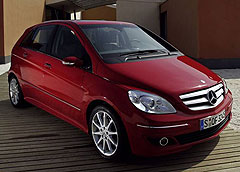News - Mercedes-Benz - A-classMercedes’ small-car conundrumAged: The average age of Australian A-class buyers exceeds 60. Benz wants to lure new and younger buyers with its grey-brigade baiting A and B-class28 Sep 2007 MERCEDES-BENZ has revealed that it is facing conflicting challenges in creating its next-generation of small cars. According to Dr Klaus Maier, executive vice-president of Mercedes Car Group sales and marketing, the future replacement for the A and B-class range must attract both new and younger buyers, but without alienating the current customer base. “If we look to the future, one of the concerns and responsibilities… is that … we have to do everything we can to keep those customers in the brand, and not to lose them,” he revealed. “We have to find concepts and ways and means to keep the customers with the brand." However, with the average age of the A-class private buyer breaching 60 in Australia and 54 globally, and remaining mature in many markets, Mercedes admits that it failed in one of the prime objectives in creating the A and B-class in the first place. Only as a company car has the Mercedes small-car duo gained some traction with people in their 30s and 40s, but this is in Europe and it usually has to do with the fleet buyer – rather than the user-chooser – picking an A or B-class. “We need to gain new customers because it is obvious that we did not achieve one target at the time, and that was to gain much younger customers,” Dr Maier said. “So we have to make a decision of how we can bring the traditional A and B-class customer and to make a concept that attracts younger people.  Left: Mercedes-Benz B200 Turbo. Left: Mercedes-Benz B200 Turbo.Launched 10 years ago this month in Europe, the original W168 A-class, as well as its W169 and related B-class replacements, relied on unique appearance, extremely efficient packaging and class-leading crash-test performance, which were the upshot of a tall body striding a ‘sandwich floor’ layout that enabled the engine to pass underneath the passenger compartment in the event of a serious accident. Such engineering solutions were deemed advanced enough for Mercedes to pitch its small car against the segment establishment led by archrival Volkswagen with its Golf. “To enter this kind of segment as a Mercedes, you need to have a USP (unique selling proposition), otherwise it is just a me-too product,” Dr Maier said. However, since then, the A-class’ perceived lack of cabin material quality has dogged it, although Mercedes deftly dodged a potentially disastrous safety-related issue when a pre-production press car was rolled over, forcing the company to standardise ESP stability control – at the time an emerging and expensive safety option – that has led to its widespread availability on many cheaper vehicles today. On the other hand, the subsequent firmer suspension revisions created a harder ride, while the A-class’ steering feel and handling qualities have lagged behind some of its sportier rivals. Nevertheless, Dr Maier refused to comment on speculation suggesting that Mercedes will abandon the ‘sandwich floor’ concept on its next-generation of small cars, or even the front-wheel drive layout. “I would not differentiate a Mercedes from a non-Mercedes brand by the drivetrain concept,” he quipped. “We have shown front-wheel drive Mercedes (cars), and they have been accepted as a Mercedes.” Read more:Mercedes exercises exclusivity |
Click to shareMercedes-Benz articlesResearch Mercedes-Benz A-class pricing
Motor industry news |














Facebook Twitter Instagram